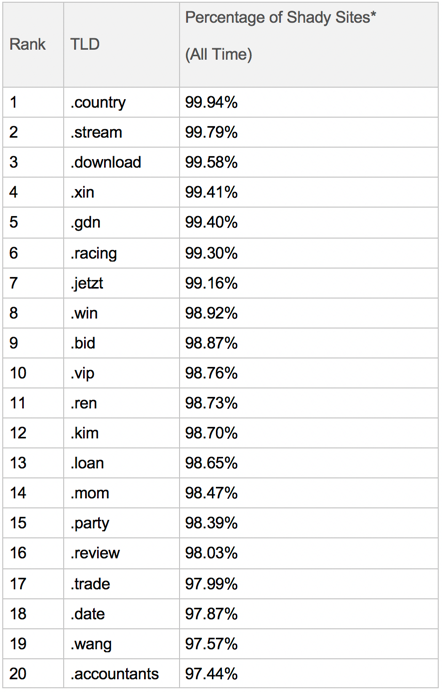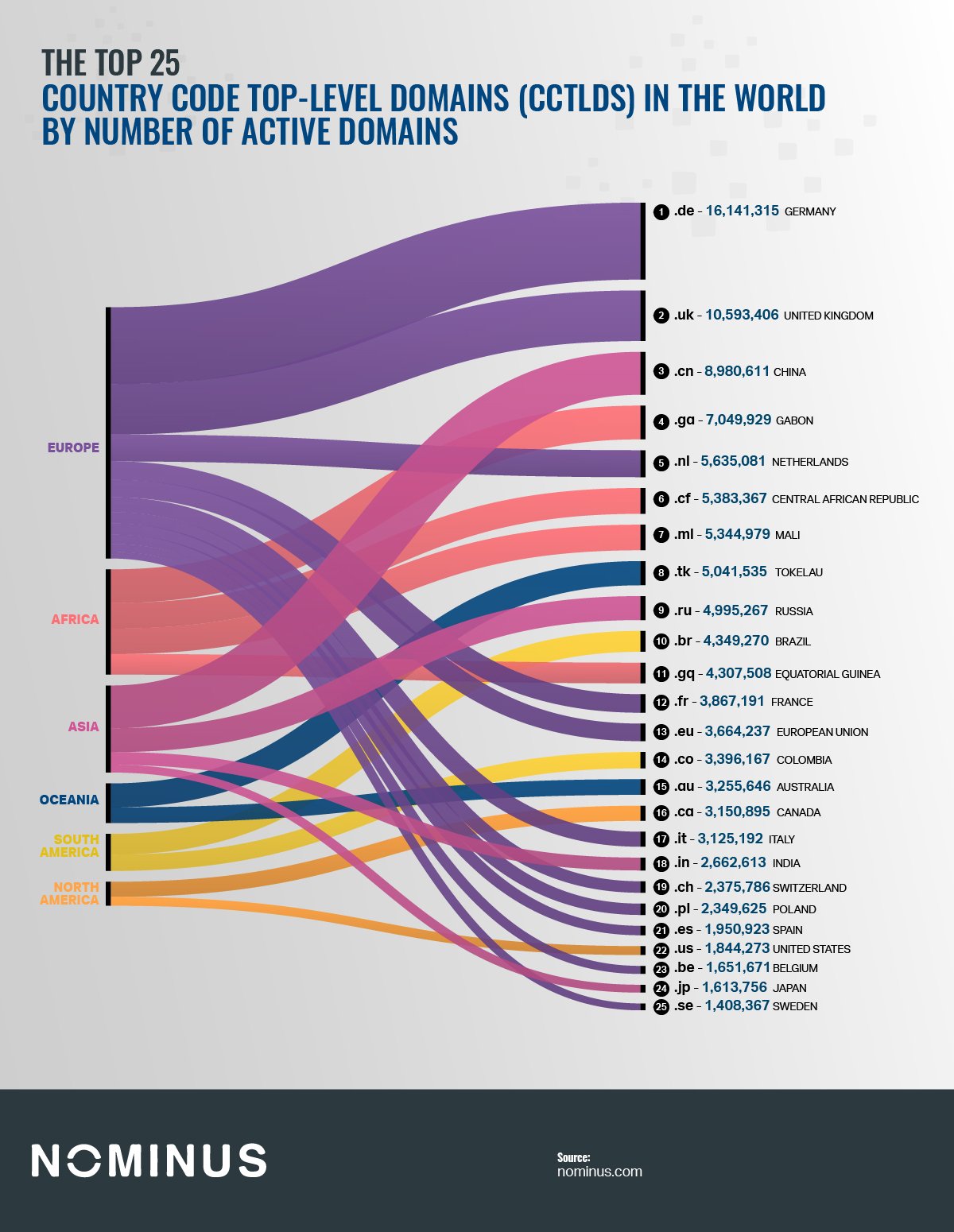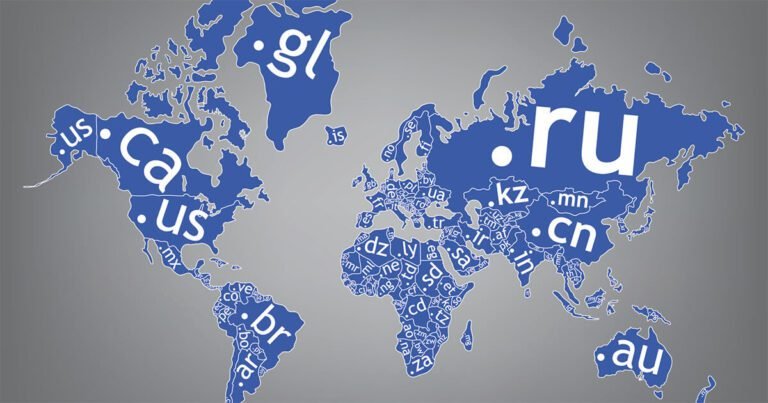Choosing the right domain for your website can greatly impact your online presence. One key aspect to consider is the top-level domain (TLD), which can vary by country.
Understanding these domains helps you select the best option for your needs. A top-level domain is the last part of a web address, like .com or .uk. Each country has its own specific TLD, which can signify where your website is based or what audience it targets.
This list is crucial for webmasters, businesses, and anyone looking to establish an online identity. Knowing the TLDs associated with different countries can guide your choice, improve your site’s credibility, and enhance search engine optimization. Explore our comprehensive list of top-level domains by country and make informed decisions for your online journey. For reliable hosting options, consider Hostinger for your website needs.

Credit: www.security.com
Introduction To Country Code Top-level Domains (cctlds)
Country Code Top-Level Domains, or ccTLDs, are essential parts of the internet. They represent specific countries or regions. Each ccTLD consists of two letters, following the dot in a web address. For example, “.uk” stands for the United Kingdom, while “.jp” is for Japan. These domains help identify the origin of a website.
Understanding Cctlds And Their Purpose
ccTLDs serve several important purposes:
- Localization: They help businesses target local markets.
- Trust: Users often trust sites with local domains.
- Search Engine Optimization (SEO): ccTLDs can improve rankings in local search results.
Using a ccTLD can enhance a brand’s visibility. It shows that a business is serious about serving its local audience. This can lead to better customer engagement and loyalty.
The Role Of Cctlds In Global Internet Structure
ccTLDs play a significant role in the global internet landscape. They help organize the vast number of websites. Each country manages its own domain namespace. This decentralization supports local internet governance.
Here are some key aspects of ccTLDs:
- Identification: Each ccTLD uniquely identifies a country or territory.
- Regulation: Local authorities regulate the registration process.
- Market Development: They encourage internet growth in developing regions.
In summary, ccTLDs are more than just web addresses. They connect users to local content and services. This connection strengthens the global internet community.

Credit: www.nominus.com
The Importance Of Cctlds For Local Presence
Country Code Top-Level Domains (ccTLDs) play a vital role in establishing a local online presence. These domains indicate the country a business serves. They help customers identify businesses that operate within their region. Using a ccTLD can significantly enhance trust and credibility.
Boosting Local Business Credibility
Having a ccTLD boosts your business credibility. Customers prefer local businesses. A ccTLD shows you are committed to the local market. It signals that you understand local needs and preferences.
- Trust: Local domains build trust with customers.
- Familiarity: Customers feel more comfortable with local domains.
- Relevance: Local domains help businesses appear more relevant.
Using a ccTLD helps in building a loyal customer base. This loyalty can lead to repeat business and referrals.
Enhancing Search Engine Optimization (seo) Locally
ccTLDs can greatly improve local SEO. Search engines recognize local domains. This recognition can lead to higher rankings in local search results.
- Localized Content: ccTLDs encourage localized content creation.
- Geographic Targeting: They help search engines understand your target market.
- Search Visibility: Local domains can enhance visibility in local searches.
Using a ccTLD can help your website attract more local traffic. Increased visibility leads to more potential customers. It positions your business as a local leader in your industry.
Comprehensive List Of Cctlds
Country Code Top-Level Domains, or ccTLDs, represent unique internet addresses for specific countries. These domains help identify websites associated with particular nations. Each ccTLD consists of two letters that correspond to a country or territory. Understanding ccTLDs is essential for web developers, businesses, and marketers.
An Overview Of Global Cctlds
Global ccTLDs serve as identifiers for countries worldwide. Here are some key points:
- Each ccTLD is unique to its nation.
- They help in localizing websites.
- Usage of ccTLD can improve SEO in specific regions.
Below is a table of some popular ccTLDs:
| Country | ccTLD |
|---|---|
| United States | .us |
| United Kingdom | .uk |
| Canada | .ca |
| Germany | .de |
| Australia | .au |
Unique Characteristics Of Regional Cctlds
Regional ccTLDs have distinct features. Here are some examples:
- .eu – Used by countries in the European Union.
- .asia – Represents Asian countries and regions.
- .africa – Targets businesses in the African continent.
Specific characteristics include:
- Targeted marketing opportunities.
- Enhanced local trust and credibility.
- Support for regional languages and cultures.
Cctlds Versus Generic Top-level Domains (gtlds)
Choosing the right domain extension is crucial. Two main types are country code top-level domains (ccTLDs) and generic top-level domains (gTLDs). Understanding their differences helps in making informed decisions.
Key Differences
ccTLDs represent specific countries or regions. Examples include:
- .uk for the United Kingdom
- .ca for Canada
- .de for Germany
gTLDs are more general. They include extensions like:
- .com
- .org
- .net
Here are some key differences:
| Feature | ccTLDs | gTLDs |
|---|---|---|
| Location Specific | Yes | No |
| Usage | Local businesses | Global reach |
| SEO Benefits | Local SEO advantages | Widely recognized |
When To Use Each
Choose ccTLDs for:
- Targeting local audiences
- Building trust in specific regions
Opt for gTLDs when:
- You want a broader audience
- Your brand has a global focus
Strategic Considerations For Businesses And Individuals
Businesses must think carefully about their domain choice. ccTLDs can enhance local credibility. They signal commitment to that market.
For individuals, gTLDs offer flexibility. They are often easier to remember and widely accepted. This is important for personal branding.
Consider these factors:
- Your target audience
- Brand recognition
- Future growth plans
Choosing wisely ensures your online presence aligns with your goals.
Navigating The Registration Process For Cctlds
Registering a country code top-level domain (ccTLD) can be simple. However, each ccTLD has unique rules. Understanding these rules helps streamline your registration.
Understanding Eligibility And Restrictions
Each ccTLD has specific eligibility requirements. These often include:
- Residency: Some ccTLDs require you to reside in that country.
- Business Registration: Companies may need to register locally.
- Documentation: Proof of eligibility might be necessary.
Restrictions vary by country. Some ccTLDs are open to anyone. Others limit registration to local citizens or businesses. Check the official registry for detailed rules.
Steps To Secure A Cctld For Your Website
- Choose Your ccTLD: Select a domain that fits your needs.
- Verify Eligibility: Ensure you meet local requirements.
- Find a Registrar: Use a reliable domain registrar.
- Gather Documentation: Prepare any necessary documents.
- Complete Registration: Fill out the registration form.
- Pay Fees: Submit payment for the domain.
- Configure DNS: Set up your domain’s DNS settings.
After registration, monitor your domain regularly. Keep track of renewal dates and any changes in eligibility requirements.
Case Studies: Success Stories With Cctlds
Country Code Top-Level Domains (ccTLDs) play a crucial role in building local trust. Many businesses have thrived by using these domains. They help connect with local audiences and expand globally. Here are some success stories showcasing how ccTLDs made a difference.
Local Businesses Going Global
Local businesses often use ccTLDs to build their brand. This helps them reach customers in specific countries. Here are some examples:
- Company A: A small bakery in France used .fr. They saw a 50% increase in online orders after launching their site.
- Company B: A clothing brand in Brazil chose .br. They expanded their reach by 30% within a year.
- Company C: A tech startup in Germany adopted .de. They gained local trust and doubled their client base.
These businesses show that a local domain can boost visibility. It builds trust in local markets and helps attract more customers.
Global Brands Connecting With Local Audiences
Even large brands benefit from ccTLDs. They use local domains to connect with customers. Here are some notable examples:
| Brand | ccTLD | Impact |
|---|---|---|
| Brand X | .uk | Increased sales by 25% in the UK market. |
| Brand Y | .ca | Gained 40% more local followers in Canada. |
| Brand Z | .au | Enhanced brand loyalty among Australian customers. |
These global brands illustrate how ccTLDs can enhance local marketing efforts. They show the importance of understanding local markets.
Challenges And Considerations With Cctlds
Country Code Top-Level Domains (ccTLDs) offer unique benefits. They help businesses establish a local presence. However, using ccTLDs comes with challenges. Understanding these challenges is crucial for success.
Legal And Regulatory Hurdles
Each country has its own laws regarding domain registration. These laws can vary widely. Businesses need to comply with local regulations. Failure to do so can lead to legal issues.
- Registration Requirements: Some countries require local presence.
- Dispute Resolution: Certain ccTLDs have strict dispute processes.
- Renewal Policies: Different countries have various renewal rules.
Understanding these legal aspects is vital. Non-compliance can lead to losing the domain.
Language And Cultural Barriers
Language differences can create challenges. Websites using ccTLDs should resonate with local audiences. This may involve translating content. It is important to consider cultural norms and preferences.
- Localization: Tailor content to fit local culture.
- Language Translation: Ensure accurate translations for better engagement.
- User Experience: Design should cater to local tastes.
Ignoring these factors may result in poor user experience. This can affect website traffic and business growth.
Future Of Cctlds In A Changing Digital Landscape
The future of country code top-level domains (ccTLDs) looks promising. As the digital landscape evolves, ccTLDs will adapt to new challenges. More businesses are recognizing their importance. Local domains enhance trust and relevance. This shift is crucial for global brands targeting local markets.
Impact Of New Gtlds And Domain Trends
New generic top-level domains (gTLDs) are changing the domain landscape. They provide more options for businesses and individuals. Here are key impacts:
- Increased Competition: More choices lead to greater competition.
- Branding Opportunities: Unique gTLDs help in brand differentiation.
- Market Segmentation: gTLDs cater to specific industries or interests.
Despite these trends, ccTLDs remain relevant. They connect businesses to local audiences. Users often trust local domains more. This trust can lead to higher conversion rates.
Predictions For Cctlds Adoption And Evolution
Experts predict several key trends for ccTLDs in the coming years:
- Growing Popularity: More businesses will choose ccTLDs for local presence.
- Increased Localization: Websites will focus on local content and languages.
- Better SEO Performance: Local domains may rank higher in local searches.
- Enhanced Security: More emphasis on secure domain registration practices.
As businesses expand globally, ccTLDs will play a vital role. Their adaptability will ensure they remain a key part of the digital strategy.
Expert Insights And Tips For Choosing The Right Cctld
Selecting the right country code top-level domain (ccTLD) is crucial for your online presence. It can affect your website’s visibility, audience engagement, and local trust. Here are some insights and tips to help you make an informed choice.
Best Practices For Cctld Selection
Choosing a ccTLD involves several important steps. Follow these best practices:
- Understand Your Audience: Know where your target audience is located.
- Research Local Regulations: Each country has its own rules for domain registration.
- Consider Brand Consistency: Align your ccTLD with your brand image.
- Evaluate SEO Benefits: A local ccTLD may improve local search rankings.
- Check Availability: Ensure your desired domain name is available in the ccTLD.
Avoiding Common Pitfalls In Cctld Management
Managing a ccTLD can present challenges. Here are common pitfalls to avoid:
- Ignoring Local Hosting: Hosting your site locally can improve performance.
- Neglecting SSL Certificates: Secure your site with an SSL certificate.
- Forgetting to Renew: Set reminders for domain renewals to avoid losing it.
- Overlooking Local Content: Create content that resonates with the local audience.
- Misunderstanding ccTLD Restrictions: Be aware of any restrictions on who can register.
By following these expert insights and tips, you can effectively choose and manage your ccTLD. This will enhance your online presence and foster trust with your audience.
Conclusion And Key Takeaways
A top-level domain (TLD) identifies specific countries online. Understanding this list helps users choose the right domain for their websites. Remembering the TLDs can simplify online navigation and enhance global reach.
Recap Of Cctld Benefits And Challenges
Country Code Top-Level Domains (ccTLDs) offer unique advantages and challenges.
- Local Relevance: ccTLDs help businesses connect with local audiences.
- SEO Benefits: Search engines favor local domains for regional searches.
- Trust and Credibility: Local domains can enhance user trust.
Challenges include:
- Regulatory Restrictions: Some ccTLDs have strict registration rules.
- Limited Global Reach: They may not appeal to international customers.
- Management Complexity: Managing multiple domains can be cumbersome.
Final Thoughts On Navigating The World Of Cctlds
Understanding ccTLDs is crucial for online success.
Choose a domain that aligns with your target market.
Consider using a ccTLD for local businesses.
Evaluate the benefits against any potential challenges.
Research regulations for the specific ccTLD you want.
In summary, ccTLDs can strengthen your online presence.
They provide a way to connect with local users effectively.

Credit: ict-pulse.com
Frequently Asked Questions
What Are Top-level Domains (tlds)?
Top-level domains (TLDs) are the last part of a domain name. They represent the highest level in the domain name hierarchy. Common examples include. com,. org, and. net. Each TLD can indicate the purpose of the website or its geographical location.
Why Are Country-specific Tlds Important?
Country-specific TLDs, or country code TLDs (ccTLDs), help identify a website’s geographical origin. They enhance local search engine optimization and trust among users. Using a ccTLD can improve your site’s visibility in specific countries. This is crucial for businesses targeting local markets.
How Do I Choose The Right Tld?
Choosing the right TLD depends on your audience and goals. If your business is local, consider using a ccTLD. For global reach, a generic TLD like. com may be better. Research the TLDs relevant to your industry to ensure maximum impact and recognition.
Can I Use Multiple Tlds For One Site?
Yes, you can use multiple TLDs for one website. This strategy can help you reach different audiences in various countries. However, ensure that each TLD directs users to the same content. This practice can enhance brand recognition and improve your search engine rankings.
Conclusion
Understanding top-level domains helps you choose the right one for your needs. Different countries offer unique domain extensions that can enhance your online presence. Knowing this information is essential for businesses and individuals alike. It allows you to target specific audiences effectively.
Explore various options and find the best domain for your website. For reliable web hosting and domain registration, consider [Hostinger](https://hostinger. com? REFERRALCODE=1ESRAT82). Their services are user-friendly and come with excellent support. Start your online journey today with the right domain choice.

I have been working as an SEO Expert in Bangladesh for a long time and now providing the best SEO Service in Bangladesh. With the approach to Semantic SEO that eschews superfluity. I can get your business web page at the top of the SERP list. Using the latest digital marketing trends, I can enhance your online visibility and drive more website traffic.
